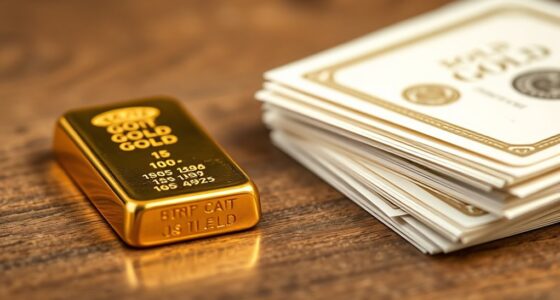When choosing between a gold IRA and a gold ETF for retirement savings, consider whether you want direct ownership of physical gold or easier trading access through shares. A gold IRA offers tangible assets with tax advantages but involves higher setup and storage costs, while a gold ETF provides liquidity and lower fees but faces higher taxes on gains. To make an informed choice tailored to your goals, explore more about each option’s benefits and limitations.
Key Takeaways
- Gold IRAs offer tangible ownership and tax-deferred growth, suitable for long-term, secure retirement savings.
- Gold ETFs provide liquidity, easy trading, and lower initial costs, ideal for flexible, short-term exposure.
- Consider tax implications: IRAs have deferred taxes, while ETFs may face higher capital gains rates of up to 28%.
- Physical gold in IRAs involves storage and custodial fees, whereas ETFs have management fees but no physical handling.
- Your investment goals, risk tolerance, and preference for physical assets versus liquidity should guide your choice.

Are you trying to decide between a Gold IRA and a Gold ETF for your retirement savings? Both options give you exposure to gold, but they serve different investment styles and goals. A Gold IRA involves the direct ownership of physical gold or other precious metals stored in a secure facility. You hold tangible assets, which can provide a sense of security and confidence in your investment. To set up a Gold IRA, you’ll need a custodian and a storage facility approved by the IRS. You’ll purchase physical gold, which is then stored on your behalf, and your account grows tax-deferred until you withdraw funds in retirement.
A Gold IRA entails owning physical gold stored securely, offering tangible security and tax-deferred growth for retirement.
In contrast, Gold ETFs are investment funds that track gold prices through shares traded on stock exchanges. You don’t own the physical metal directly but instead buy and sell shares like stocks. This setup offers greater convenience and liquidity since you can trade ETF shares during market hours without waiting for shipment or storage arrangements. Gold ETFs are managed by professionals, providing instant access to gold exposure without the hassle of handling physical assets.
Tax treatment is another key difference. Gold IRAs offer the same tax advantages as traditional IRAs, with gains growing tax-deferred until withdrawal, which can help your investments compound over time. When you retire and begin withdrawals, taxes are due then. On the other hand, Gold ETFs are taxed as collectibles, with a maximum long-term capital gains rate of 28%, which is higher than typical stock investments. While ETFs may be easier to report for taxes, their less favorable tax rate can cut into your long-term gains.
Cost considerations also matter. Setting up a Gold IRA can be expensive due to initial setup fees, custodian charges, storage costs, and insurance. Over time, these costs can add up, making it a more costly option. Gold ETFs generally charge annual management fees that range from 0.25% to 0.40%, plus possible brokerage fees when buying or selling shares. While these fees are lower upfront, they can erode returns over many years due to compounding.
Liquidity and trading flexibility are significant advantages of ETFs. They trade like stocks, so you can buy or sell shares instantly during market hours. Gold IRAs, however, involve physical metals that may take time to sell and transfer, leading to lower liquidity and potential delays. Early withdrawals from a Gold IRA might also incur penalties, whereas ETFs offer more straightforward access, though tax implications remain.
Both options serve as inflation hedges. Gold has historically outpaced inflation by about 3% annually over decades. A Gold IRA provides direct backing with physical gold, making it a tangible hedge. ETFs track gold prices but don’t grant physical ownership. Your choice depends on whether you prefer owning physical assets or the convenience of paper investments. Additionally, understanding the personality traits of investors can influence their comfort with physical versus paper assets, as some individuals prioritize tangible assets for security.
Frequently Asked Questions
Can I Transfer Existing Retirement Funds Into a Gold IRA or ETF?
Yes, you can transfer your existing retirement funds into a Gold IRA or Gold ETF. You’ll need to do a rollover or transfer, which involves moving funds from your current account directly to the new investment without tax penalties. Make sure to follow the specific procedures for each option, and consult with a financial advisor to guarantee a smooth process and compliance with IRS rules for tax-advantaged accounts.
What Are the Tax Implications of Investing in Gold IRAS Versus ETFS?
Investing in a Gold IRA or ETF is like choosing between a safe vault and a flexible wallet. With a Gold IRA, you typically face tax-deferred growth until withdrawal, but you pay taxes then. An ETF offers liquidity and often fewer tax complications, as you’re taxed on gains annually. You might prefer an IRA for long-term growth and ETFs for easier access, but understand each’s tax rules first.
How Do Gold ETFS Physically Store Their Gold Compared to IRAS?
Gold ETFs store their gold in secure, insured vaults managed by trusted custodians, and you never see the physical metal. In contrast, gold IRAs hold physical gold stored in approved depositories, with the custodian handling the storage. When you invest in a gold IRA, you’re purchasing actual gold stored for you, while ETFs offer a more flexible, paper-based investment that tracks gold prices without physical possession.
Are There Restrictions on How Often I Can Buy or Sell Gold ETFS?
No, you generally aren’t restricted on how often you can buy or sell gold ETFs. You can trade them as frequently as the market allows, much like stocks. However, keep in mind that frequent trading might lead to higher transaction costs and tax implications. Always review your investment strategy and consult a financial advisor to make certain your trading frequency aligns with your long-term retirement goals.
What Are the Costs Associated With Setting up and Maintaining a Gold IRA?
Setting up a gold IRA typically costs between $50 and $300 for account setup, with annual maintenance fees ranging from $75 to $225. You’ll also pay for storage, which usually costs around $100 to $200 annually, and possible transaction fees when buying or selling precious metals. These costs vary by provider, so it’s smart to compare options to find the most affordable plan that suits your retirement goals.
Conclusion
So, whether you pick a gold IRA or a gold ETF, remember that your “secure” retirement might just depend on which shiny asset you trust more. Ironically, both options offer exposure to gold’s glittering appeal, but only one lets you hold actual gold in your hands someday. So, go ahead—choose your path, knowing that in the end, your retirement savings are as unpredictable as a gold rush. Happy investing!









